I wish we had one. There is no rhyme and only a few disjointed reasons for what happens at the small storage nursery at the maintenance shops. This is nothing like acres of production nursery full of rhododendrons, azaleas, camellias and such. Nor is it like the retain nurseries that sell the rhododendrons, azaleas, camellias and such. This is merely a small yard where we store a few plants that get removed from landscapes, and plants that were recently procured from a nursery but have not yet been planted.
It is like the nursery version of the wood shop, with its collection of new lumber and old recycled lumber that gets used on the historic buildings. The plumbing shop contains all sorts of new plumbing and fixtures, as well as many old fixtures that might someday be useful. The landscape shop, which is separate from the nursery, is #7 of about twelve specialized shops used by the maintenance staff. The nursery might seem to be the most dysfunctional of the several shops, but only because plants are dynamic and need maintenance . . . and because, without necessary maintenance, a few have deteriorated, died or conversely thrived and made themselves at home.
Newly procured plants like #5 and #6 are easy to work with. They come in with a plan, and generally leave within a week or two as they get installed out somewhere in the various landscapes. Recycled plants like #1 and #2 were removed from the landscapes either because they were in the way of something, or because they proliferated too much, but could someday go back into other landscaped areas. Then there are a few plants like #3 and #4 that stay long enough to disperse roots through the bottoms of their cans and into the ground, essentially planting themselves on the spot because they got tired of waiting for a new home.
1. Peruvian lily was so prolific at the Post Office that many needed to be pulled. They were canned to be installed elsewhere, but no one wants to put them into a situation where they might proliferate like they did at the Post Office. Besides this pink, there is also peachy pink and yellow. All are the tall types that were originally grown fro cut flowers, rather than the lower mounding home garden varieties. Consequently, they need to be staked or caged like tomatoes so that they do not lay on the ground.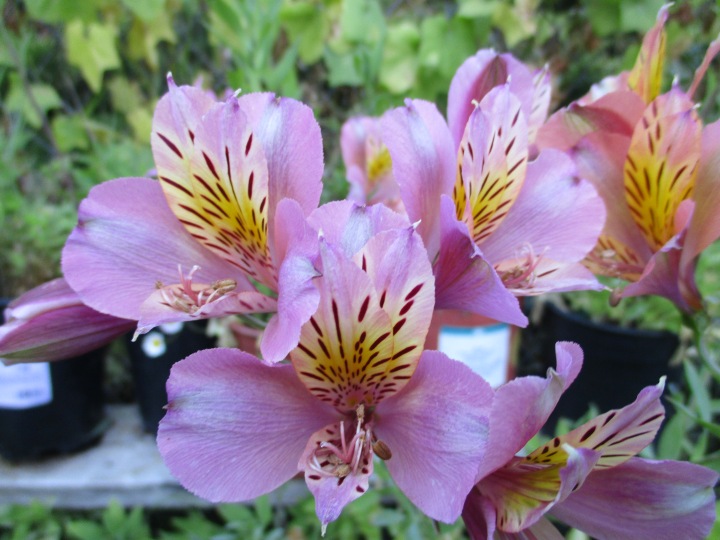
2. Chrysanthemum was grown as annuals in a few various locations, but when they were removed to relinquish their space for more seasonable annuals, a few were canned. It is not always easy to discard certain perennials just because their time is up. The problem is that, although they look so good in the nursery, and bloom in spring instead of autumn, they do not get cycled back into the landscape. When new color is needed, it is often purchased and planted before the old stock is considered.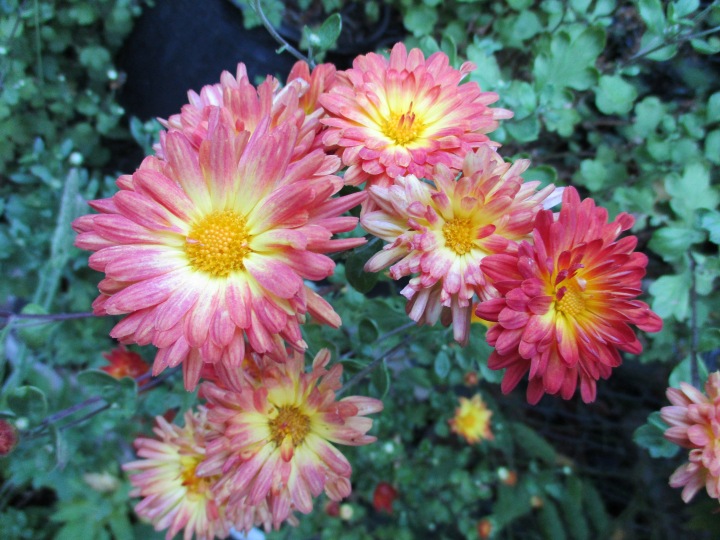
3. Potato vine has been growing like a weed on the cyclone fence and shade structure for so long that no one knows where it came from. I do not even know where the vines originate from. I would guess that somewhere under the overgrowth, the main canes emerge from the remains of a #1 can that the roots split apart years ago. This vine lives here now. Even if we had a spot for it, relocation is not practical. If it gets too overgrown, it might get cut back.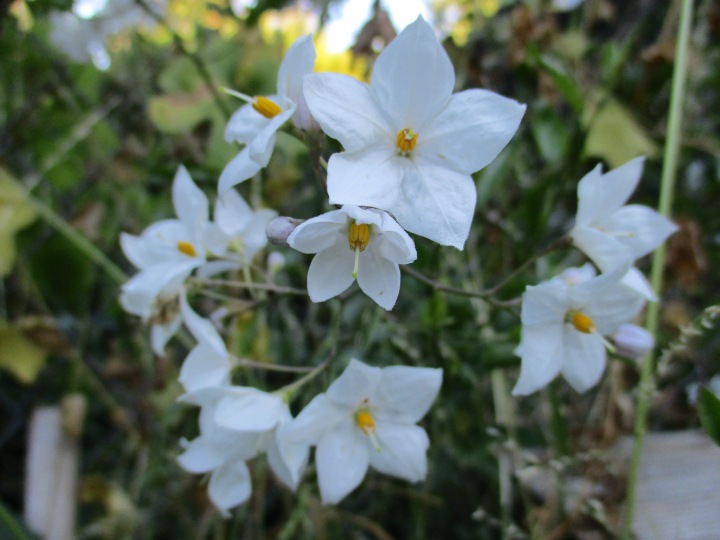
4. Campanula was probably in a 4” pot that got set into the #15 can of a ‘Black Lace’ elderberry and forgotten about. It might have been recycled, or it might have been something new that never got installed. Before the elderberry was relocated, the campanula had spread into the cans of other trees, so like the potato vine, it lives here now.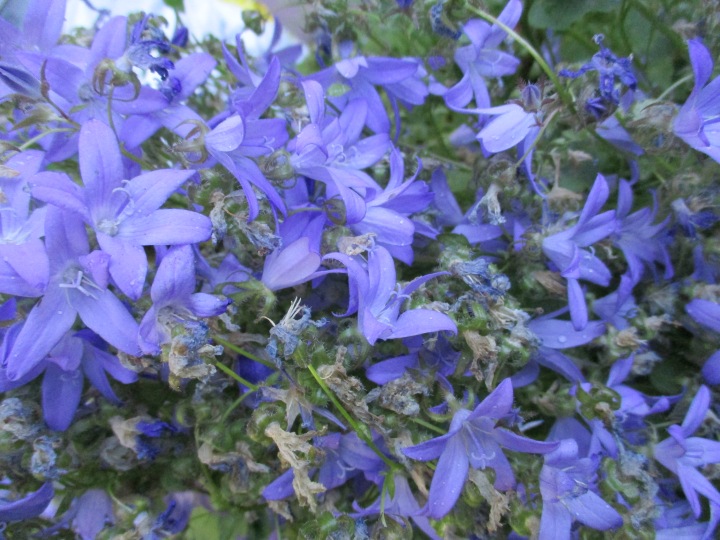
5. Cone flower is easy. I just arrived from a nursery, and will be installed into a landscape in just a few days.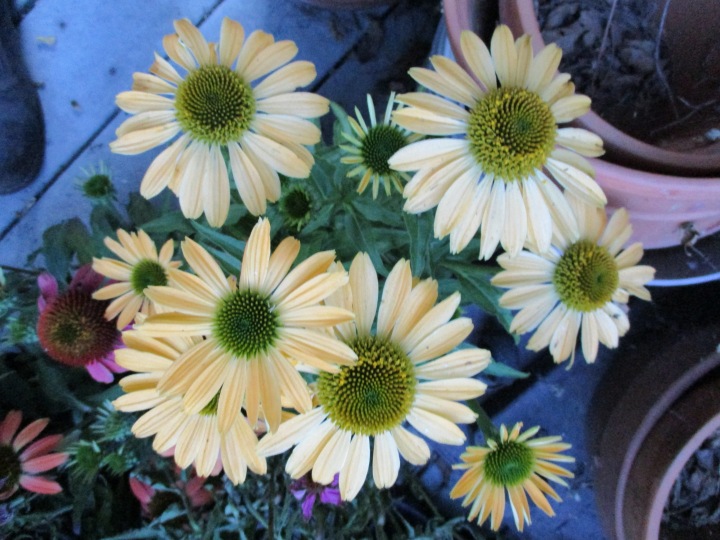
6. Yarrow came with the cone flower, and will be planted nearby in the same landscape at about the same time.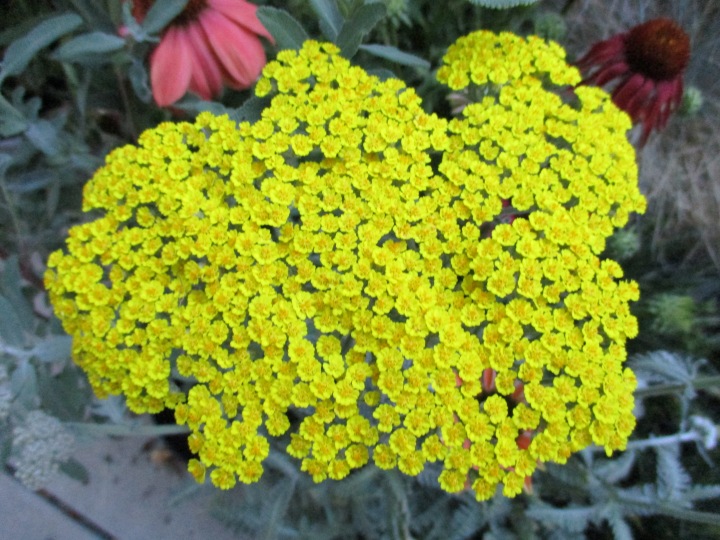
This is the link for Six on Saturday, for anyone else who would like to participate:
https://thepropagatorblog.wordpress.com/2017/09/18/six-on-saturday-a-participant-guide/
Interesting post, Tony. It is funny how plants just end up in places and thrive or die depending on suitability. Kind of the opposite of “gardening”. Like the potato vine very much. They are so prolific and long lasting. If you have the space, they are great along a fence or wall.
LikeLiked by 2 people
This one is on a fence . . . and a wall . . . and a hedge and a nearby roof and a spruce tree and I think one of the trucks is missing. Oh my! It needs to be cut back.
LikeLike
Morning Tony. I like the look of that Peruvian Lilly. Will have to see if I can get it across here.
LikeLiked by 2 people
Although the tall types need to be caged or staked, I think that they are so much prettier than the shorter garden varieties.
LikeLike
I relocate my plants by putting them on the roadside outside my house with a sign “free” on them. They usually go.
LikeLiked by 3 people
Well, that is effective. I got giant yucca, banana tree and many bearded iris from the green waste recyclery piles in San Jose.
LikeLiked by 1 person
I like the color of your Peruvian lily. I also have 2 other rather red but this one is adorable. Except flowers and shade, is potato vine attractive for something else? I don’t know this species (how does it resist in winter?)
LikeLiked by 2 people
It is not my favorite. It gets rather weedy, and favors the parts that get the most sunlight while abandoning the parts that are more shaded. It survives winter here, but is not very frost tolerant. It can get frosted even here. I just took a picture of it because the flowers just happened to be pretty.
LikeLiked by 1 person
I would happily take every one of them over here! There’s some competition for the Peruvian Lilly. I recently donated a selection of geraniums and some self seeders to a friend’s new garden. It cleared some space and I meant less watering for me.
LikeLiked by 2 people
With Phytophthora ramorum in our region, we should not send anything out. Besides, it would not be practical. These old school types can be grown from seed.
LikeLiked by 1 person
I enjoyed your recycled nursery center views, Tony. I’ve never seen that variety of coneflower.
LikeLiked by 1 person
They were a common mix of coneflower. I have never planted them before. My last coneflower were there before my time. This will be a first for me.. I know nothing about them.
LikeLike
Wish I lived a bit closer Tony as I would happily take the Peruvian lily and potato vine (though they probably wouldn’t like our climate). You can keep the campanula though – we have oodles of what looks like the exact same one.
LikeLiked by 1 person
You are the second offering to rehome the Peruvian lily. Even if it could, I could not send them out due to the Phytophthora ramorum in the region.
LikeLiked by 1 person
Just had to look this up to discover it is a plant pathogen that kills oak trees – we definitely don’t want any of that!
LikeLiked by 1 person
No! It killed countless acres of coast live oak and shut down the Farm for more than a year.
LikeLiked by 1 person
Interesting Six Tony, I enjoyed reading about the plant storage yard. Sound a lot like the back end of my garden…
LikeLiked by 1 person
Yes, I suppose many active gardens have similar spots to some degree, right next to the morgue.
LikeLike
I’m late to comment but here I am.
Lovely 6 as ever. I had a potato vine once and it was a gorgeous purple but it actually pulled down a fence so I have stayed clear since then! They are pretty but, like you say, quite a rambler. X
LikeLiked by 1 person
Purple? Was it potato bush, Solanum rantonnetii?
LikeLiked by 1 person
No it was a solanum crispum but I call it a potato bush? not sure if that’s right!
LikeLiked by 1 person
Oh, that is a different species that I am not familiar with. I have heard the name, but I do not remember it.
LikeLiked by 1 person
Lovely six. I love alstroemeria. It needs a bit of support but never mind it makes a great show.
LikeLiked by 1 person
Thank you. When I grew them in 1986, they were rare, and our plants were leased! We were not allowed to propagate them! I had been trying to find more of those tall types for years, and grew only the old salmon pink variety. Now it seems that there are too many, although only three varieties.
LikeLike
I have two cream and orange, I don’t know the names but they are both gorgeous.
LikeLiked by 1 person
For those old tall ones, I do not think that names are important. In fact, those that lack names, but are merely selections of the same Alstroemeria ligtu might be some of the best. I think that those with names are so fancy that all the spots and streaks and stripes and such interfere with the actual color. I see a cream colored one downtown, and I really like it because it is the closest to white that I know about.
LikeLike